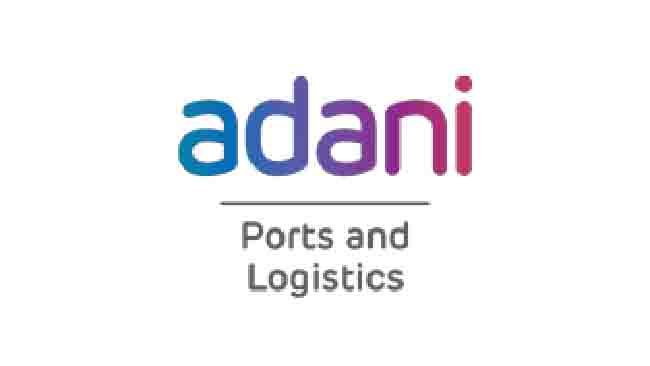
Adani ports and Logistics
Ahmedabad, May 6th 2020:
Adani Ports and Special Economic Zone Limited (“APSEZ”), India’s largest integrated logistics player and part of Adani Group, today announced its operational and financial performance for the fourth quarter and year ended 31st March, 2020.
Financial Highlights of
FY20:-
|
Particulars (Rs.in cr.) |
Q4 FY20 |
Q4 FY19 |
Growth |
FY20 |
FY19 |
Growth |
|
Operating Revenue |
2,921 |
3,082 |
(5%) |
11873 |
10925 |
9% |
|
|
|
|
|
|
|
|
|
Consolidated
EBITDA * |
1,644 |
1,932 |
(15%) |
7,565 |
7,067 |
7% |
|
|
|
|
|
|
|
|
|
Consolidated
EBITDA margin |
56% |
63% |
|
64% |
65% |
|
|
|
|
|
|
|
|
|
|
Forex
mark to market -Loss/(Gain) |
1004 |
(109) |
|
1,626 |
476 |
|
|
|
|
|
|
|
|
|
|
PBT |
257 |
1,583 |
(84%) |
4,244 |
5,126 |
(17%) |
|
|
|
|
|
|
|
|
|
PAT |
361 |
1,300 |
(72%) |
3,800 |
4,006 |
(5%) |
*Consolidated
EBITDA excluding forex mark to market loss/ (Gain).
Operating Revenue (Y
o Y): -
Ø Operating
Revenue grew by 9% from Rs.10,925 cr. in FY19 to Rs.11,873 cr. in FY20 on
account of 8% increase in Port revenue and 65 % increase in Logistics revenue.
Consolidated EBITDA* (Y o Y): -
Ø EBITDA
grew by 7% from Rs.7,067 cr. in FY19 to Rs.7,565 cr. in FY20 on account of 7%
growth in cargo volume and 159% increase in Logistics EBIDTA.
Consolidated
PBT and PAT (Y o Y): -
Ø Profit before
Tax was Rs.4,244 cr. in FY20 compared to Rs.5,126 cr. in FY19.The decrease is
on account of forex mark to market loss of Rs.1,626 cr.
Ø Similarly,
Profit after Tax was at Rs.3,800 cr. in FY20 compared to Rs.4,006 cr. in FY19,
the decrease is on account of forex mark to market loss of Rs.1,626 cr.
However, there is no cash flow impact for the MTM accounting.
Ø EPS for FY 20 was at Rs.18.35.
Ø Net Debt to EBIDTA remains at 2.9x better than the desired level of
3x to 3.5x.
Ø Balance sheet
continues to be strong and all our credit matrices are within the guided range
or better.
Operational
Highlights FY20: - (on YoY Basis)
Ø Cargo Throughput was 223 MMT a growth of 7%.
Ø Handled record container volume of 6.25 mn TEUs thus registering a
growth 8%
ü
Mundra continues to be the largest Commercial Port, handling 139
MMT of cargo volume during the year.
Ø During the year Dhamra
port registered a record cargo growth of 44% and handled highest cargo volume of
~30 MMT, since inception.
Ø We are working towards
achieving east coast and west coast parity in terms of distribution of assets
and hinterland reach. In FY 20 in terms of volume handled this is at 20%:80%
against 15%:85% in FY 19.
Ø Logistics
business has grown substantially during the period, rail volume increased by
115%.
Ø ALL currently operates 60
rakes and is the largest private rail operator in India.
Mr. Karan Adani, Chief Executive
Officer and Whole Time Director of APSEZ said “Our strategy to diversify and ability to handle
all types of cargo enabled us to outperform and deliver another year of stellar
operational and financial performance. In FY20, we added LNG and LPG into our
cargo portfolio. We have also increased our logistics footprint by focusing on
increasing connectivity to our ports through our own rakes, inland freight
terminals, warehousing solutions and concentrating on end mile connectivity.
This enables us to provide an integrated logistics service to our customers and
bring them to our port gate.
As
a strategy, we always maintain a liquidity cover of 2x. In FY21, we will reduce
our operating costs and Capex will be curtailed to Rs.2,000 cr. Focus will be on conserving cash, generating
higher free cash flow and increasing the ROCE from our business.
Considering current situation due to spread of
COVID-19, we are Implementing Govt. of India operating
procedures at all our ports with safety of the workforce as a top priority.
Operational
staff is quarantined at ports with necessary arrangements in place for safe
work environment.Hygiene, sanitization of workplaces & sites are a top
priority and has enabled 100% thermal scanning. Majority of our administrative
staff are working from home.
Ports fall under essential
services and as such all our ports are operating efficiently during this period
of crises to ensure that supply chain of essential goods is not
disrupted.”